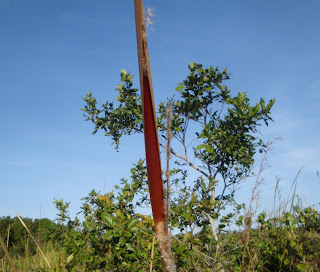Has it's uses though. The fibre is tough and durable and can be used to make baskets and handicrafts, even paper. In Turkey the flower stalk is applied to burns and wounds and apparently works quite well.
Perhaps it's most beneficial property though is as a sponge. As it grows, taboa absorbs vast amounts of material from the water around it, most of which accumulates in it's tissues. So taboa beds can absorb Phosphorous from agricultural runoff which would otherwise cause algal blooms, or even heavy metals like Zinc from mining pollution. You just wait and then cut and take away the reeds. There are several studies around the world deliberately making lagoons of Typha dominguensis as a low cost way of cleaning waste water.
 It's hard to say whether taboa is such a benefit environmentally. It swamps (as it were) native species in clean water, but cleans polluted water so that other creatures can survive, as well as providing cover for insects and small fish. Anyway, it can be very useful for us humans.
It's hard to say whether taboa is such a benefit environmentally. It swamps (as it were) native species in clean water, but cleans polluted water so that other creatures can survive, as well as providing cover for insects and small fish. Anyway, it can be very useful for us humans.


1 comment:
Grown under proper (clean water and soil) this is one of the most productive food plants there is. It is also a dessication machine that kills lakes and rivers. It is a silt making machine that will raise a lake bed out of contact with the groundwater, to the destruction of both. Typha Australis in Lake Chad is the driving force behind North Africa's desertification. It is all biofuel, processable in many ways. Thanks for helping increase awareness of it.
Post a Comment